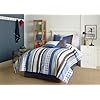Holiday Decorating and Staging: Do They Mix?
Now that the holiday season is officially here with Thanksgiving behind us, I have clients wondering "is it Ok to decorate for Christmas (or Chanukah) even though we're selling our home?"
The answer: Yes, but on a scaled-down, tasteful level. Don't put up an 8-foot tree unless you live in a very large house with a huge room where it will look scale appropriate. Even then, pare down the whole of decorations elsewhere so that visitors (i.e. Buyers) aren't overwhelmed with holiday décor, especially village collections, ornaments on tables, dressers, hanging from lights, etc. And holiday-themed pillows, towels, placemats, tablecloths and bedding. All of that will look like clutter, which is a cardinal sin when it comes to staging! It will also look fantastic to anyone but the most die-hard Christmas lovers, and you run the risk of turning buyers off with too-personal choices in décor. Save hanging the stockings and putting out presents for Xmas Eve.
What is the best type of décor to use? A particular wreath on the front door, and natural greenery, white candles, and classy silver and gold ornaments add tastefulness to any home, as long as they are used in diminutive amounts, such as on a mantel and dining room table. Think "Pottery Barn" and you'll get the right idea!
Hopefully, it goes without saying to avoid putting out any religious items, such as Nativity sets indoors or out, or menorahs, in fact anyone outdoors other than greenery and white lights is risking an overdone or "tacky" look. Avoid inflatable Christmas decorations that are overly market when they are up and running, and look like laundry on the ground during the day.
If you undoubtedly feel you won't enjoy the holidays without dressing up your house to the nines, then hold off on listing - or put a moratorium on showings - until after the holidays. If buyers feel overwhelmed by lots of cute decorations, they won't be able to appreciate your home's features.
Tags : Weber GasGrill Outdoor City of Fallen Angels PIERRE DE FERMAT ACCOMPLISHMENTS Electronic Mouse Trap

